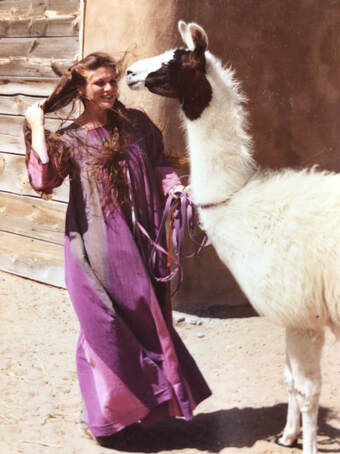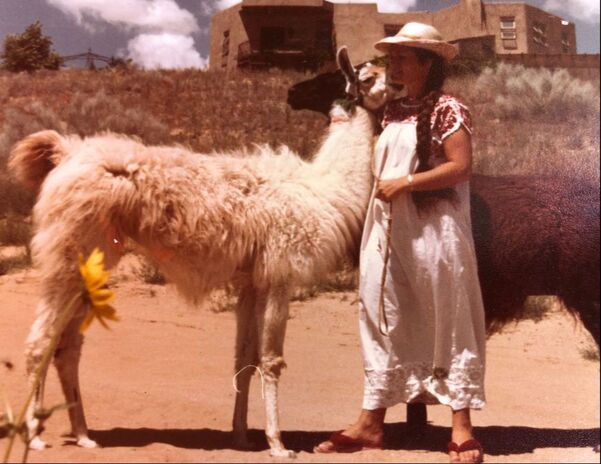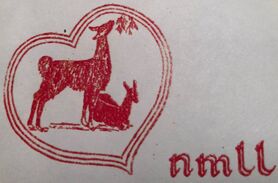To some people, llamas are livestock to be used. To others, llamas are pets to enjoy seeing in the field. To Betsy, llamas are like relatives to care for and love -- up close and personally.
|
Betsy Bell was one of the first generation of llama owners in New Mexico. She was a cherished member of the llama community who gave her dedicated love to her llamas that continues after her passing. As a dear friend, Director of Southwest Llama Rescue, Pat Little says, “Betsy Bell is everything Good”. Born Elizabeth Rose Bell in 1938 the eldest of nine to Saul and Olive Bell. Her parents were the originators of the prestigious Saul Bell Design Award for jewelry design known worldwide. Betsy worked alongside her father in the jewelry shop and fostered her artistic nature and brought beauty into everything she did. Betsy shared some of her story with me on a fall afternoon in 2016. What she did not share was that she had stage 4 cancer and at that time would only have another 6 months to live. Betsy was a bright-minded original. She was striking in appearance, in her conversation, and her demeanor. She was quick to correct anyone mispronouncing “llama” to make sure one did not mistake the origin of these wonderful creatures. Betsy did things her own way, and was a pioneer in understanding how to work with llamas. In 1978 Olive saw an ad in Sunset Magazine showing pretty llamas that just said, “Llamas are Fun”. That got Olive and Betsy excited and they wrote a letter to Kay Patterson (who owned 500 llama in Sisters, Oregon and posted the ad) inquiring how to buy llamas. Kay directed her to her customer in Pojoaque, New Mexico; Scott McCullough and Chet Smith (Scott’s ranch manager). In 1978 Olive and Betsy got their first two llamas after some amount of cajoling given Scott’s initial reluctance to talk with Olive and Betsy. Betsy then joined the ranks of the first generation of llama owners in New Mexico, Chet Smith and Don and Jodi Sleeper (Addis) and in Colorado Bobra Goldsmith and Howard Kerstetter (first president of RMLA), who were also friends. Betsy ultimately owned at least 26 llamas used for showing, training, fiber, driving, companions/pets, and breeding and was the primary caretaker, trainer, and marketer. Betsy’s entrepreneurial spirit was unleashed with the opening of Campana Llama Ranch. She also began the Llama Lover’s Association of New Mexico and brought llamas and their folks together for large events of llama showcasing. She organized and led the New Mexico State Fair Llama Obstacle course for 3 years. Betsy designed wonderful logos for her Campana Llamas, Llama Lover’s Association, RMLA, and made her own letter heading artwork and calligraphic letterings for her correspondence (she started Llamagraphics in 1985) and llama marketing. Betsy was involved with llama rescue and she generously hand wrote every “Thank You” note to the donors of Southwest Llama Rescue (SWLR) for many years in her calligraphic hand. All of her llamas were registered with the International Llama Registry and she gave operatic names to everyone starting with the first two: Rumpelstiltskin and Copelia. Other wonderful names included Rigoletto, Oberon, Candide, Scheherazade, Parsifal, Don Giovanni, Peer Gynt, Micaela, and Escamillo. Proudly Betsy stated, “In 30 years, I have never shorn any llamas – only brushed them. This keeps all the guard hair in place for the llama and removes only the fine fibers, which are then aligned nicely into roving to be sold to spinners.” Betsy would add a photo of the llama and calligraphed name and short story with each bag so the buyer could request “more of that nice Scheherazade, please” as needed. Daily, Betsy would call each llama forward for their supplemental feed (“nibbles”) to the brushing spot and they would eat while being brushed. This was also the routine for when they got their nails trimmed. Betsy was worried for the llamas who got sheared annually. She noticed that on even numbered years her llamas grew more wool than the odd years meaning they must have needed more wool then - perhaps for the harsher winters. So, automatic shearing might result in those llamas being cold for those winters where their bodies were generating more wool but it was being stripped off equally every year. Betsy used the repetition and discipline from her ballet training and classes that she gave to children for years. She created and taught a class she coined, “Talk to the Animals” and demonstrated the benefits of interspecies communication. Betsy once wrote down the entire vocabulary she taught her llamas and counted 83 words! “One day” Betsy said, “I told Scheherazade (who kept playing with the water hose), ‘go through the gate, into the Run-and-jump [name for one of the corrals], and get a drink of water from the bucket’, and she did it!. After that, I tested the other llamas to see if they would understand and most of them did.” Betsy also enjoyed being part of a highly energetic group she worked with, the Enchantment Driving Society, who Betsy described, “were a thrill to be involved with; an event every month, in addition to their monthly meetings for 11 years! Rarely did they miss having something going on”. They drove llama carriages and organized events continually with energy and enthusiasm. Betsy’s devotion to animals included volunteering at the Rio Grande Zoo where she worked with the llamas and alpacas. She ultimately designed her own halter that showed off their faces and fit around the ears. To Betsy, “a llamas beautiful face should be shown and not covered by the halter”. Her llama posters read, “Campana Llamas is one of New Mexico’s oldest herds with the North American, ‘Old Style’, Tall and Elegant llamas with enough fine wool to look beautiful but not so much that you can’t see their marvelous bone structure.” To some people, llamas are livestock to be used. To others, llamas are pets to enjoy seeing in the field. To Betsy, llamas are like relatives to care for and love -- up close and personally. The later generation of New Mexico llama owners that Betsy was involved with included the founders of Southwest Llama Rescue (2001) by FE Baxter and Pat Little who became very close with Betsy. In her later years, as Betsy was caring for her mother, the time came when she needed to find care for her llamas. She surrendered her last twelve llamas to SWLR and sent funding to provide for their care and feeding and donated her trailer hand built by her brother. Betsy’s sister, Molly, managed Betsy’s estate to her wishes which was to give generously to causes that Betsy was dedicated to. We at SWLR are deeply grateful that most Betsy’s estate was given to SWLR in a trust to continue the mission of caring, advocating, talking to the llamas and educating people on the highest quality llama interaction. Thank you, Betsy, for who you were and how you continue to help us even as you are gone.
1 Comment
|
AuthorLynda Liptak is the founder of Llamas del Sol and is dedicated to sharing the awesomeness of llamas. She has only owned llamas since February 2009 but it has been a very in-depth involvement. Lynda and her family have four wonderful trekking llamas with very different personalities. Lynda has been studying camelid dynamics since the start of her llama adventures and is an active member of Marty McGee's Camelidynamics Forum. She has completed the Basics Clinic (three times!) to include the shearing course, medication administering, and has hosted the Camelidynamics Basic training at the Llamas del Sol ranch. She is a past ski-instructor certified by the Professional Ski Instructors of America and an Emergency Medical Technician - Basic. She is also holds a masters degree in operations research from the Colorado School of Mines and works part time at Applied Research Associates, inc. as a scientist. Archives
September 2023
Categories
All
|









 RSS Feed
RSS Feed